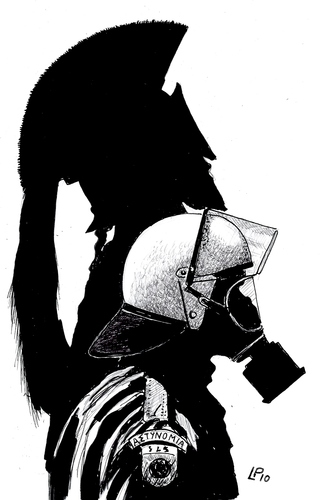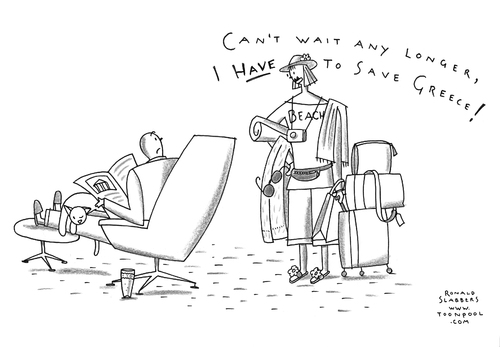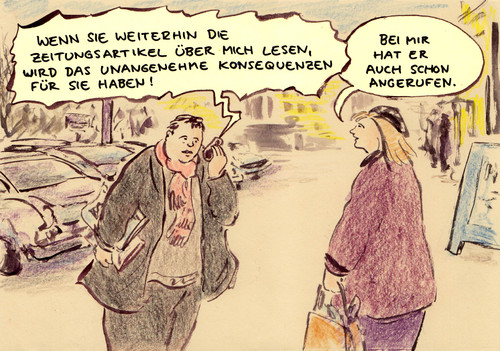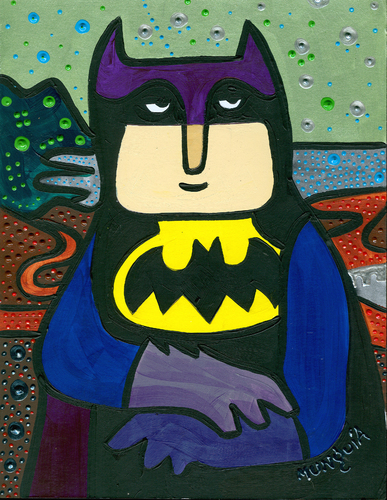Interview with Greek Professor of Modern and Contemporary History Aristotle Kallis (41), living in the United Kingdom and teaching at the Lancaster University
toonpool.com: “Zorba the Greek“, written by Nikos Kazantzakis, is a very famous Greek novel and a treasure of world literature, of course also world-renowned as the film of the same name (1964) starring Anthony Quinn. In that story Zorba has to repair a collapsed mine in the Greek countryside. In order to do that, he goes downtown to purchase building material. But he goes to the dogs with a fast woman, with drinking, dancing and sleeping, and he blows all the money – even though he’s responsible for the country people who subsist on wages from working in the mine. Though he’s penniless, he doesn’t surrender: he constructs a ropeway to transport logs from a mountain above the mine, in order to use them as supporting pillars. His undaunted optimism is so likeable – but during the first test run, the ropeway implodes in a big noisy crash – a complete disaster. Aristotle, do you think: Yep, that’s Greece! Is it an early omen for the current situation of the country? The Greeks are in love with life as the story says, but – what the heck! – they never become discouraged by failures, catastrophes or death, and if they fail, they simply get up and start over. Is this the typical Greek mentality, or have the Greeks lost their characteristic optimism since becoming embedded in the euro zone?
Aristotle: You mention Zorba by Kazantzakis – one my favourite authors’ least favourite book. Generations of Greeks grew up with this image of the one who knows better, who does things in the most unorthodox manner, who tries and fails and tries again and fails better (one of my favourite quotes by Beckett!). The story is accurate in so many respects, not all of which are positive: the maverick, yes, full of love for life, ready to try the most extraordinary thing and fail but then get up as you say and try again; the person who follows a bizarre inner voice, the thrust of emotions, the exaggeration of language, the harshness of the Greek summer landscape. But there is a side to the stereotypical Zorba that’s far from flattering: the person who does not recognise rules and is willing to find excuses to bend them to their benefit; who defies reason and celebrates flight from rationality; who is convinced of their intelligence against all odds, even if reality crushes them; who thinks first and foremostly about themselves; who embrace exaggeration and tragedy even if this means that they themselves will be crushed in the end. But Zorba (and, let’s face it, most people know the cinematic rather than the literary hero) is of course a stereotype, a caricature with deliberately blown-up charisma and flaws. He is a penniless bon-viveur, a man of extreme passion and clouded judgement, a blinded individualist, a charming crook. He is the epitome of human contradiction.
 The Greeks of 2012 are far less enamoured with life, even if they have not entirely lost their knack for enjoyment. Greeks today are confronted with a very tangible and debilitating reality – of lost jobs and reduced wages, of closed shops and wounded pride, of real insecurity and a sense of profound decadence. I travel to Greece every two or three months- and I saw a very real difference in the last year or so. People feel trapped, cornered, trashed, fooled – it does not matter if they really are any of these things; they believe they are, they think they are, and this is what matters to them. This is the kind of psychological state that allows false prophets to flourish and makes people willing to worship them temporarily.
The Greeks of 2012 are far less enamoured with life, even if they have not entirely lost their knack for enjoyment. Greeks today are confronted with a very tangible and debilitating reality – of lost jobs and reduced wages, of closed shops and wounded pride, of real insecurity and a sense of profound decadence. I travel to Greece every two or three months- and I saw a very real difference in the last year or so. People feel trapped, cornered, trashed, fooled – it does not matter if they really are any of these things; they believe they are, they think they are, and this is what matters to them. This is the kind of psychological state that allows false prophets to flourish and makes people willing to worship them temporarily.
Greeks also love pompous, pulsating rhetoric. They have an inflated collective ego – from history primarily but also from a sense of perseverance, against all odds. They are the archetypical proud, morally unassailable victims of a tragedy. They thrive on exaggerated rhetoric, on declarations of national bravado, on a kind of almost childish obstinacy when confronted with their own failings. An eternal teenager mentality if you wish, unwilling to heed the boring advice of their elders, convinced they know better, almost relieved from accountability that applies to everyone else. In this respect, Zorba is an eternal teenager too. His failings are romantic and likeable – but failings they are. Greeks today engage in finger pointing, in scapegoating, in unfiltered anger, indignation, and an extreme sense of reckoning that never includes their own responsibility.
Have they lost their sense of rationality and sanity? I don’t think so. It is just that in times of real crisis and tribulation human behaviour tends to become magnified. The virtues and the flaws, individual and above all collective. The veneer of ‘Europeanisation’ that at least three generations of Greeks tried to live up to has come undone, exposing deep insecurities about who Greeks are and who they wish to be. The sense of achievement that my generation experienced from EU membership and then joining the euro means far less to people in their 20s now. I do not fully blame them. For me and my friends, the euro meant a moment of symbolic triumph; for them it has become associated with crisis, lack of prospects, a harsh everyday reality, a lack of inspiring vision.
Zorba’s love of life and enthralling life philosophy contrast sharply with his flaws and failures. His beautiful language and thoughts are almost tragic when viewed against the backdrop of his maverick actions and misfortunes. For sure he is not afraid of failure or death; but this exposes a sense of unaccountability and moral superiority that are misplaced and misguiding. He is a tragic antihero, trapped in a hostile reality but unable to change it and unwilling to change in order to change it. He lives in his own rhetoric and relives drama in every waking moment. In the end, he fails and falls, with a lightness that is both endearing and devastating.
toonpool.com: Ancient Greece is regarded as the cradle of European democracy. The ancient Greeks were pioneers in politics, philosophy, arts, natural sciences, technology, and many other disciplines, and their achievements continue to influence peoples and nations all over the world. Does this fact still play a role today?
Aristotle: In the complex, volatile, vulnerable psyche of the modern Greek, it does, very much so; and it has become the ultimate psychological refuge when all other rational or semi-rational arguments have run out. Greeks believe that the world owes them – and this is a very interesting kind of analogy to use by a debt-ridden nation! There is a historical installment that others are constantly repaying to Greece; and there is a parallel with the past (of heroism, of obstinate refusal to accept reality, of fighting – and often losing – but with heart-breaking pride … think 300!) that the modern Greek will use to dismiss any attempt to remind them that the country is heading for a spectacular, devastating crash. My personal favourite is the ownership of the trademark ‘Europe’ – after all it was the Greek forefathers who imagined the story with the woman/cow and the besotted promiscuous father of the gods that gave us a foundation myth for a continent. Can there be Europe without Greece? Of course not, say many (in fact, probably a sizeable majority) of my compatriots, because it was the Greeks who over the centuries gave meaning to the very sense of European identity as a humanistic, democratic, refined civilisation.
Here is a bit of an alternative example – in the Eurovision song contest of 2012 the winning song was titled ‘Euphoria’. Now, this is a Greek word. When I was talking to some of my friends, I was shocked to find out that most of them thought that we (the Greeks) have a mission to inform the rest of the world (and the Swedes in particular, who won the contest) that they owe this word to us! Seriously. What does this (and other examples along the lines of a constant, impossible to repay debt of the world to the Greeks) illustrate? You have a nation that never really seriously bothered to redefine itself as a modern political and culture entity. Trapped between the proverbial east and west, wanting to belong to both and neither at the same time, Greeks lived in the past, basked in the glory of a long bygone era, and created the illusion of an entitlement – to respect, reverence, special treatment etc etc. In the discussions surrounding the drafting of the ill-fated European constitution last decade, Greeks were given numerous opportunities to feed this kind of illusion. This, incidentally, is the same illusion and rhetoric that brought Greece in the EC back in the late-1970s, when countries such as Germany and The Netherlands and Britain had serious reservations about the rationale behind the country’s entry: it made no sense economically, it was deeply unsettling in political terms (in 1979, when Greece’s membership was agreed, the country’s democracy was only five-years old!) – and yet, lead by the French, the notion that it was ‘impossible’ to have ‘Europe’ without Greece won the day; the Germans were convinced, and the rest is history. This rhetoric may not matter to many Europeans today (and rightly so, for the kind of challenges we are facing are not metaphysical or historical but very tangibly political and economic) but it is supremely important to the psychology of the modern Greeks. Remember how the Greek president reacted to the (rather crass, it has to be said) criticism by Wolfgang Schaeuble – he invoked the imagery of a wounded, diminished, inert but fiercely proud sleeping giant against the power of Europe’s ‘nouveau riche’ (the entire ‘western’ Europe) and used it to attack the attacker with a kind of emotional blackmail. So it is not just street philosophers and everyday people who are deeply embedded in this structure; politicians have no problem using it, whether because they believe it themselves or as a mechanism for boosting the morale of Greek society.
toonpool.com: Medical progress means that citizens of most Western societies are getting older, an effect which is supported by healthier eating. Starting in the 1960’s, Greek (and Italian) eating habits have revolutionized the cookery of the Western world. In Germany for example, gastronomy is unthinkable without Feta cheese, Tzatziki, olives and olive oil, garlic, Dolmadika, Choriatiki and many other Greek dishes. Do you think Mediterranean peoples, who are now in huge economic difficulties, have made other societies ready for the struggle for survival and for success in business – playing the role as perfect Southern nutritional advisers?
Aristotle: Maybe! But let us avoid the temptation to add this item to the long list of things that others owe to Greece! Incidentally, most of the dishes that you quote above have an Ottoman or Arabic provenance; they were defined during centuries of fascinating plural life in the Ottoman empire, where a true sense of ‘Balkan’ or ‘Ottoman’ culture did emerge. The Greek cuisine is a particular take on this kind of food and culture lifestyle. Ottoman does not of course mean ‘Turkish’; the latter was also part of it. It is ironic that politically Greece expended the last six decades denying this past while culturally continued to embrace it as its own. It is also equally ironic that it is dolmadakia and choriatiki salata that are the most immediate experiences of ‘greek-ness’ for many Europeans – much more so than philosophy, theatre, classical architecture etc!
toonpool.com: Germany has incited two world wars, and committed atrocities in Greece and other countries. After the crash it received generous support from the USA for a rapid recovery and a new prosperity. Ok, the USA had an agenda, but don’t you think it is a bizarre paradox that the Germans – represented by Angela Merkel, Wolfgang Schäube and some other German politicians, commercial experts and media – now are setting conditions and dictating to other countries in trouble? Are Greek fears of an upcoming “Fourth Reich” reasonable?
Aristotle: The imagery of a Fourth Reich is very strong in Greece – and it is part of the same Greek contemporary populism (of both left and right) that has meshed with the beliefs in an eternal debt by everyone to Greece for all the great things that ancient Greeks ‘gave’ to the world. Greek journalists have fed this monster and it is now almost uncontrollable. There is a new political party (Independent Greeks) that uses these kinds of metaphors all the time in its official discourse. Think also of another powerful discourse in Greece – reparations for the atrocities of the Nazis in the 1941-44 period. It is hard to shake off this stereotypical image, I am afraid. I have almost maintained that Germany has now found itself in a paradoxical position – and one that I believe never really wanted: it *has* to behave like the gigantic power that she really is; postwar Germany expended considerable efforts to disguise this newfound power; it behaved like the benevolent giant, shy and introverted, hesitant and overcautious, who always tried to pretend that it is far less powerful and important to the European process than it objectively was. Kohl excelled in this, when he was going around Europe trying to allay fears of a German resurgence post-1989 – and he framed German politics to that effect up until very recently. Now, Germany has been forced to confront its own power and assumed responsibility vis-a-vis the European project. The Merkel government gave voice to a mentality and attitude (shared silently by many Germans, including new generations) that Germany does not need to feel guilt for its contemporary power. The taboo is broken – see the recent book by Sarrazin about Germany leaving the euro because it is fed up of picking up the tab for others. If I were to extend the same analogy that I used for Greeks earlier (that of an unruly teenager), then Germany acts like the reluctant prudent parent; reluctant because in the past s/he used this power in a rather authoritarian manner but post-1945 was forced to take the back seat and watch numerous European ‘teenagers’ go about their business in unorthodox, quirky ways. Germany now pays the price for its spectacular success and prudence – and it is this position, as the undisputed powerhouse of contemporary Europe, that forces Germany to be more assertive in the context of the current crisis. In this new role, Germany is very much doomed – it will be loaded with all sorts of stereotypes about Bismarck and Hitler, about 1914 and 1939. It is very common in Greece to see Schaeuble presented in cartoons as a tank – and I know that this kind of populist, essentially insulting discourse is replicating itself in other countries too. Merkel has started shattering the taboo of German power in contemporary, euro-defined Europe – if the country is a giant, if it is the key to the success or rescue of the eurozone and the only prospect of kickstarting the economic fusion that leads to growth, then it has to act as one, it has to stop pretending that it should not and cannot. This kind of attitude will not go down well but there are few other alternatives.
The ‘Fourth Reich’ analogy is of course a hideous stereotype, steeped in prejudices and cliches about the past. It is also an idiotic argument that reduces a complex contemporary political and economic reality to a kind of mechanistic pattern of ‘history repeating’ – which of course it never does. But there is an element of universal truth in all this discourse: power translates itself in influence, responsibility, and hegemony, and disproportionate power does so disproportionately. Think of the USA in the post-1989 world; it is impossible to disguise this power and it is impossible to resist the temptation to wield it. In many ways, Germany’s attitude in the past two decades was the exception to this universal rule: there is probably no other example of such a mismatch between (real) power and refusal to wield it (in fear that others may invoke the imagery of WW2). What is happening now is a less palatable but more accurate correspondence between actual power and political behaviour. It was inevitable that Germany would be asked (or tempted) to assert this authority in the EU; it would have been better had this been done at a time of relative calm and growth but it had to happen in the midst of a debilitating economic crisis and social upheaval.
toonpool.com: Aristotle Onassis married the widow of a man who once said: Ask not what your country can do for you – ask what you can do for your country. Could that idea become an inspiration for Greece? And have rich men like Onassis done enough for their country?
Aristotle: Modern Greeks have grown up with a schizophrenic attitude to the Greek state and their country. On the one hand, they are in love with its stereotypical image of a slightly faded superpower of the past, a cultural giant that is falling apart but still maintains a large part of its veneer and commands the loyalties of others. On the other hand, they are deeply distrustful vis-a-vis the state, which they consider corrupt, inefficient, unsuitable etc. It is very difficult to convince Greeks today (as it was in the past) to accept a kind of collective, civic responsibility towards the state. Think of the attitude of Greeks to taxes: the way in which many Greeks evade taxation is a kind of bravado, an act of insubordination against an allegedly corrupt Greek state that they loathe. Think of their attitude to everyday corruption: laws are there to be disregarded because at the end of the day Greeks are fiercely individualistic, in a way that makes the notion of social responsibility a very vague concept to them. Generations of Greeks grew up with a sense of individual entitlement that did not include any sense of civic duty to the state and their country – the same ‘country’ that they putatively love and use emotively in their everyday language. This is a very comfortable, if bizarre and schizophrenic rationalisation: if the state is corrupt and inefficient, then people can individually benefit from a low-level corruption (anything from asking your friends in the police to cancel your fines for breaking the speed limit to bribing the urban planning office in order to bend regulations about your newly built house, etc) while at the same time castigate that same state for corruption and inefficiency to the point that their conveniently refuse to accept responsibility for it. When JFK was appealing to a well-embedded sense of emotional and constitutional patriotism among the Americans (a notion that remains very powerful even today), a Greek politician asking the same (as some have done…) will invoke the derision of his/her audience: who is he, the corrupt and discredited politician who is asking us for sacrifices? It is as if ‘the state’ is a kind of hostile estate of the politicians, the bankers, the proverbial rich, the global capitalists etc. etc. that has nothing to do with everyday Greek people. There is ‘a country’ out there that everyone vows that they love and respect; and ‘a state’ that is some kind of dictatorship ‘of others’ ruling this ‘country’, a dictatorship that deserves only derision and definitely no element of commitment from the Greek people. Unfortunately, this is a collective stance that has become even more powerful in the post-2008 period; the movement of the ‘indignant’ in Greece allowed many to scapegoat ‘the state’ as the only responsible for economic and social collapse.
Have rich people done enough? They never do – not only in Greece but in other countries too. Greece has a disproportionate share of very rich people – from shipowners who have taken their businesses abroad (not now; this has happened since the 1970s/1980s) to others with well-above-average income who have expended considerable energies in avoiding taxation and contributing as little as possible to the social welfare of the state. Some super-rich Greeks (Onassis is one; other shipowners and aristocrats too) have indeed contributed significant amounts of money to the Greek state – usually posthumously, it has to be added. I think that we should not just expect those very few people to solve the problem; it would have been nice but it will not happen – and probably cannot happen anyway. The problem remains, however – can contemporary Greece at last manage to devise a fair, transparent system of taxation for all its citizens, close loopholes, fight inefficiency and corruption, and thus allow the Greek state to claim that it is distributing the weight of contribution equitably across Greek society? I believe that a new kind of collective civic responsibility is what is sorely missed in Greece – and the economic crisis has strengthened the tendency towards a fiercely atomised and individualist society.
toonpool.com: Which Greece will the world see in five years?
Aristotle: Any prediction would be an exercise in science fiction. Could anyone have imagined the situation today five years ago (2007)? Absolutely not. I think that in five years time Greece will be a better place than it is today – not necessarily economically stronger or more prosperous (although I hope this is the case…) but more balanced, more aware of its position and shortcomings and fundamental flaws; more aware of its new position (even if it is a new, diminished position); more at ease with its new status (even if it is a status of a pariah or a second-tier European country). It is quite likely that the Greece of 2017 is a country outside a common European currency – or at least sharing the same currency with Germany. I fear that the coming year is the absolutely crucial test for Greece and Europe as a whole. The medium-term trajectory of the country will be largely decided in the coming twelve months or so.
I will evade a direct answer by sketching two scenarios. The good scenario is a Greece that has (or is about to do) hit rock-bottom before starting its difficult oath to some kind of recovery. It will be a country that discovers a new sense of position in Europe and is willing, after the trials of the past four years, to make the requisite sacrifices to be there, to restore its prestige and respect, to do things right in order to stop giving reasons to others to agonise about it (and give them reasons to intervene in the running of its everyday business). It will be a country with a new political class that will emerge from the ashes of the current wreck; with a new sense of patriotism derived from the same dreams of ‘Europeanisation’ and ‘modernisation’ that fuelled it in the 1970s and 1990s. It will be a Greece that is democratic and open to challenges, cooperative and at ease with its more diminished role, European but also proud of its complex history, welcoming to difference and open to hybrid identities of the future. It will be a Greece that, to use one of my favourite phrases by the former prime minister Konstantinos Simitis, will stop feeding itself with illusions of past greatness and look confidently to the future. This is a Greece that I could feel part of.
Then there is another Greece. It is the Greece of unfiltered populism – against immigrants, ‘Europeans’, ‘capitalists’ etc – and evasion of responsibility. It is the Greece that sleepwalks towards the abyss with tragic but infuriating abandon. It is the Greece of nationalism and racism, of indignation as an escape from reality and individual or collective responsibility. This Greece has no future to speak of. I cannot even begin to think what this country will look like in 2017: out of the euro, disoriented, with a society in a state of civil war, with a disorienting cultural pessimism, the kind of country that makes news for all the wrong reasons and the closest that an erstwhile ‘European country’ can come to a ‘failed state’. It is also a Greece of huge social problems – of poverty and degradation, of rapidly falling living standards, of criminality and racist attacks against immigrants, of populist parties commanding the support of many Greeks. It is a country without a future. This Greece means very little (if anything at all) to me – and I hope I will never have to confront it more than I do at the moment, when some of these forces are very much at play. Greece needs all the help she can get right now. Not just in economic terms but also in terms of shielding it from the latter kind of future.
Photos ©Aristotle Kallis
]]>For this new issue of “Letter from” column, we asked toonpool artist Kim Maxine Frost about her life and begged for some photographs of her working place and the place she lives in – Seattle, also known as “the The Emerald City”. Kim (Frostyhut) joined toonpool on July, 2009 and she wishes to double her toonpool gallery by the end of the year. Kim works as a radio announcer at Classical KING FM 98.1 (have you seen her classical music inspired cartoons?).We are also proud that Kim writes for us, so we invite you to read her great review-interviews on toonpool’s blog!
01. Which movie/tv character you see yourself as
and why?
I am totally Lynn Redgrave in Georgy Girl. She’s awkward and kooky, but it all works out. And she gets to meet James Mason! She dislikes him in the film, but he’s the best thing in it.
02. What are your New Year’s resolutions?
To get 200 drawings posted to toonpool.com. And now (gulp), I guess I really have to!
03. What bores you the most?
In the past, the most boring thing was that my work life and my creative life were split up. That’s changing though. My job just commissioned some drawings, which is nice. For the first time it’s all starting to blend together.
04. Do you like your place or would you like to live somewhere else?
Yes, I’ve never traveled. I love Seattle, but I fantasize about being somewhere warmer. Or just different. The radio station where I work airs a piece called Nights in the Gardens of Spain by Manuel de Falla. Every time I hear it, I want to go there.
05. What are you able to do that Superman can’t do?
Draw Superman? That reminds me – a couple of years ago I heard German pianist Bernd Glemser when he toured the States. He inspired me to create a character called Bernd von Mimzer, a concert pianist with superpowers. He had nipples that could shoot deadly flames. I drew about sixty pages of the comic, and then I got a full time job. I need to carve out the time to get back to Bernd. I miss him!
06. If you were sleep walking one night, where would you probably wake up the next day?
Well I’m obsessed with accessories, so my unconscious mind would probably take me to some shop filled with shoes and handbags. I’d love to wake up inside a Hermès store!
07. What would you wear to be kicked out from a black tie cocktail party
In Seattle, it’s hard to shock because anything goes. I’ve seen kilts at the symphony, jorts (jean shorts) at the ballet. I’d probably try incongruity in the same outfit – a bikini with combat boots, maybe!
08. Tell me the biggest prank you did on a friend.
I can’t think of a prank I pulled on someone else, but I remember a trick someone played on me. At an office Christmas party that was held at a nice hotel, one of my co-workers grabbed some silverware from a table setting and stuck it in my purse. I walked around all night with this silverware sticking out of my bag, and nobody told me! That’s the part I still can’t believe!
09. How to ruin your vacation?
Hot tubs have never worked out for me on vacations. Either there’s no heat, or the jets aren’t working, or both – and then you find yourself sitting in a big tub of tepid bacteria. The bacteria should at least be, you know, moving around.
10. If I gave you a giraffe, where would you hide it?
That reminds me of a line from one of Donald Barthelme’s surreal short stories: “And the giraffe’s on fire in the kitchen, but you don’t care!” Good question. I’d try to recreate the giraffe’s natural habitat, and paint the entire area to look like a jungle. Maybe do one part of it in a giraffe pattern, so the giraffe could just blend in with the background when it wanted to.
11. What do you do when you see the glass half empty!
When the glass is half empty and I start to feel down, I just buy stuff. I love pens. Right now my favorite is the Dr. Grip gel pen by Pilot. I don’t draw with it, I just make tons of lists (that I instantly lose). But I love those pens. I have them in a bunch of colors – pink, purple, emerald green. I go online and buy refills for my pens, and I feel much better.






Credits to Nicoleta Ionescu for
talking with Kim Maxine Frost
English version see below.



toonpool.com: Herr Diekmann, kürzlich hat das Bild „Der Schrei“ von Edvard Munch für knapp 120 Millionen Dollar den Besitzer gewechselt. Sie selbst haben Karikaturen-Originale von toonpool.com-Künstlern angekauft. Setzen Sie in Zeiten der Euro-Krise persönlich auf Sachwerte?
Kai Diekmann: Selbstverständlich! Ich investiere schon immer mit Vorliebe in Sachwerte. Im Ernst: Ich war im Zusammenhang mit der Affäre um Christian Wulff überrascht und beeindruckt von den vielen kreativen Ideen der Karikaturisten. Häufig haben die Künstler in ihren Zeichnungen die Situation noch besser und eindrücklicher erfasst als manche politische Journalisten in ihren Texten. Das morgendliche Zeitunglesen hat mich oft zum Lachen gebracht. Und so entstand die Idee, die Karikaturen im Original zu kaufen, die sich mit BILD und Christian Wulff befasst haben, insbesondere auch mit seinem Anruf auf meiner Mailbox. Und inzwischen habe ich eine private Sammlung von über 25 Karikaturen – als Erinnerung an diese aufregenden Wochen.
toonpool.com: Karikaturen können den Karikierten verletzen. Früher wurden Künstler deswegen von den abgebildeten Mächtigen verhaftet oder verklagt (z.B. von Franz-Josef Strauß), was in einigen Ländern auch heute noch vorkommen kann. Müssen Politikerinnen und Politiker demgegenüber heute nicht froh sein, wenn sie Gegenstand von – auch sehr spöttischen – Karikaturen sind, weil sie andernfalls an Präsenz und Wichtigkeit verlieren?
Kai Diekmann: Es ist sicherlich auch ein Zeichen von Bedeutsamkeit, wenn Politiker in Karikaturen dargestellt werden. Die Künstler beschäftigen sich ja in den Zeichnungen mit den Themen, über die die Menschen sprechen, die die Menschen im Land interessieren. Und Themensetzung ist für die Politik wichtig. Sicherlich werden manche Politiker mitunter auch nicht glücklich sein, wenn sie karikiert werden – manchmal kann es auch hart sein, der Wahrheit und Wirklichkeit, wie Karikaturisten sie sehen, zu begegnen. Mich in jedem Fall faszinieren Karikaturen: Als leidenschaftlicher Zeitungsleser erkenne ich häufig den Strich eines Karikaturisten – vor allen Dingen von den Künstlern, die ich schätze und von denen ich eine besondere, kreative Botschaft erwarte. Leider müssen aber in manchen Ländern Karikaturisten nicht nur Probleme fürchten, in einigen Ländern werden Karikaturisten regelrecht bedroht, wenn Sie beispielsweise an die berühmten Mohammed-Karikaturen von Kurt Westergaard denken. Er erlebte nicht nur eine theoretische Drohung, er ist tatsächlich nur knapp einem Mordanschlag entkommen. Daher fand ich es so wichtig, dass Kurt Westergaard vor zwei Jahren im Rahmen der Medienkonferenz M100 in Potsdam von der Bundeskanzlerin und Joachim Gauck, der damals noch nicht Bundespräsident war, mit dem M100 Medien Preis ausgezeichnet wurde. Das war ein sehr richtiges und mutiges Zeichen
toonpool.com: Als gezeichneter Kommentar steht die Karikatur oft plakativ als Eyecatcher und Seitenaufmacher auf einer Meinungsseite. Haben die Zeichnerinnen und Zeichner damit mehr direkten Einfluss auf das Publikum als die schreibenden Kollegen, zugleich aber daher auch eine höhere Verantwortung?
Kai Diekmann: Ich weiß nicht, ob die Verantwortung höher ist oder der Einfluss größer – Karikaturen haben aber auf jeden Fall eine schnellere Wirkung auf den Betrachter. Über ein Bild oder eine Zeichnung ist eine Botschaft einfacher zu übermitteln als das durch einen Text möglich ist. Meine Zeitung heißt ja aus gutem Grund nicht „Text“ oder „Schlagzeile“, sondern „Bild“ – weil sich der Erfinder, der Verleger Axel Springer, etwas dabei gedacht hat. „Bild“ sollte die gedruckte Antwort auf das Fernsehen sein, Informationen einfacher zugänglich machen und mehr Menschen zum Zeitunglesen animieren. Das menschliche Gehirn ist für Buchstaben weniger empfänglich als für Bilder, Fotos oder Zeichnungen. Eine gute Karikatur macht einfach Spaß, zaubert ein Lächeln ins Gesicht und pflanzt einen Gedanken in das Gehirn der Betrachter. Und eine gute Karikatur funktioniert im Zweifelsfall auch ohne Bildunterschrift. Getreu dem Motto „Ein Bild sagt mehr als tausend Worte“ finde ich Karikaturen mitunter auch hintergründiger und noch mehr auf den Punkt als ein Text, weil natürlich auch ein emotionaler Aspekt hinzukommt.
toonpool.com: Bei Karikaturen und Cartoons ist der Übergang vom Journalismus zur unterhaltenden und ernsthaften Kunst fließend, zugleich verändert sich die Medienwelt rasant. Sind Karikaturen ein klassisches Old School-Element des Print-Bereichs, oder haben sie auch in anderen Medien eine fortlaufende Zukunft als wichtige Zeitdokumente?
Kai Diekmann: Ganz bestimmt haben Karikaturen eine Zukunft. Ihr erfolgreiches Portal zeigt ja, dass auch in der digitalen Welt der Bedarf nicht geringer, sondern größer wird. Am Ende interessieren sich die Leser für Inhalte und nicht für den Vertriebsweg. Ich sage meinen Kollegen immer: Wir sind keine Papierhändler, wir sind Journalisten, wir erstellen Inhalte. Auf welchem Weg wir unsere Konsumenten erreichen – ob auf gedrucktem Papier, im Internet oder auf dem Handy – ist letztlich zweitrangig. Bilder sind kompatibel für jedes Medium. Gerade in Zeiten des Informationsüberflusses spielen Bilder eine große Rolle – egal ob Fotos, Comics oder Karikaturen und unabhängig ob in der Zeitung oder Online. Viele Bilder wirken auf einer digitalen Oberfläche anders als auf gedrucktem Papier und darin bieten sich für die Zeichner große neue Chancen. Online oder auf dem Tablet und dem Smart-Phone kann ich die Karikatur, das Bild vergrößern und weitere Details entdecken. Ich liebe allerdings auch Papier. Eine Karikatur mit einem besonderen Strich auf Karton gescribbelt hat etwas Wunderschönes – deshalb habe ich die Originale ja auch erstanden.
toonpool.com: Es gibt Karikaturen, die sind inhaltlich sehr schnell verbrannt, nach wenigen Wochen weiß kaum noch jemand, worum es ging. Es gibt aber auch Zeichnungen, die stehen für den Zeitgeist einer Ära, sie werden zu Zeitdokumenten…
Kai Diekmann: Natürlich! Ich glaube, alle Karikaturen, die Sie hier vor sich sehen, sind Zeitdokumente – unabhängig davon, ob sie digitaler Herkunft oder direkt gezeichnet sind. Karikaturen behandeln ja per Definition ein Sujet, das – zumindest für den Moment – im kollektiven Gedächtnis ist. Und der Rücktritt eines Bundespräsidenten, vor allem mit den Ereignissen und Diskussionen im Vorfeld, bleibt sicherlich vielen Menschen noch lange im Gedächtnis.
toonpool.com: Und das liegt natürlich auch an der Wichtigkeit der Person…
Kai Diekmann: …und an der Wichtigkeit des Ereignisses, bei Karikaturen sind das meist politische Ereignisse. Mich wundert manchmal, dass sich die Karikatur in ihrer Mehrzahl fast ausschließlich mit Politik beschäftigt. Dabei gibt es doch so viele andere Bereiche und Personen, die eine Rolle spielen. Ich könnte mir beispielsweise auch Karikaturen zu Show-Größen wie Thomas Gottschalk oder Dieter Bohlen vorstellen. Aber die findet man – wenn überhaupt – nur ganz, ganz selten.
toonpool.com: Haben Sie selbst schon einmal eine Karikatur gezeichnet oder es versucht?
Kai Diekmann: Ja, als Schüler. Das ist grauenhaft in die Hose gegangen. Ich habe ein großes Faible für Kunst in allen Darstellungsformen: Malerei, Skulpturen, Fotografie – oder eben auch gute Karikaturen. Ich habe früher leidenschaftlich gern selbst fotografiert und als Schüler auch Fotowettbewerbe gewonnen. Und das Entwickeln von Filmen und Abzügen in Schwarzweiß hat mir riesigen Spaß gemacht. Aber was das Zeichnen angeht, bin ich – leider – völlig unbegabt. Wahrscheinlich kommt daher auch meine Bewunderung für die Kunst anderer.
toonpool.com: Von welchen Politikern haben Sie die Einschätzung, dass sie besonders viel Humor (und auch die Fähigkeit zur Selbstironie) haben?
Kai Diekmann: Da gibt es viele, parteiübergreifend: Angela Merkel, Gregor Gysi, Gerhard Schröder, Karl-Theodor zu Guttenberg fallen mir ganz spontan ein. Sie können wunderbar über sich selbst lachen. Mit seinem Humor könnte Rainer Brüderle – wenn er mal aufhört, Politik zu machen – eine eigene Talk-Show ins Leben rufen oder als Kabarettist auftreten. Unsere Politiker haben durchaus Humor, das haben sie oft bewiesen. Denken Sie nur an den Orden wider den tierischen Ernst oder den unzähligen Faschings- und Karnevalsveranstaltungen, in denen eben genau die Politiker, die im Publikum applaudieren, durch den Kakao gezogen werden. Ich bin der Meinung: Ein gutes Maß an Selbstironie ist wichtig – nicht nur für Politiker. Das ist das Schöne an Karikaturen: Karikaturen machen Spaß und transportieren dennoch Kritik – auf eine feine, künstlerische Art und Weise.
…………………………………………………………………………………………………………………………………….
Interview with Kai Diekmann, editor in chief of „BILD“,
Germany’s No.1 newspaper in circulation and reach,
who has purchased original cartoons by artists
of toonpool.com…
(Diekmann and his mobile phone played key roles in the affair surrounding Christian Wulff, Federal President of Germany, who finally had to resign in February 2012. As an encroachment on press freedom, Wulff had tried to prevent the coverage concerning charges of nepotism).
toonpool.com: Mr. Diekmann, the painting ‚The Scream’ by Edvard Munch was recently auctioned for almost 120 million dollars. You yourself purchased original cartoons by artists of toonpool.com. Do you personally rely on material assets in times of the Euro crisis?
Kai Diekmann: Of course I do! I have always taken great delight in investing in material assets. No kidding: I was surprised at the cartoonists’ copious amounts of creative ideas regarding the affair surrounding Christian Wulff. Quite often I noticed that some cartoonist conveyed the situation more precisely and better with his drawings than some political journalist with his/her op-ed article. Reading the paper each morning often made me laugh. And that’s when the idea occurred to me to purchase the original cartoons dealing with BILD and Christian Wulff and especially his phone call on my voicemail. And by now, I have acquired a private collection of more than 25 cartoons – in memory of these exciting weeks.
toonpool.com: Cartoons can insult the person that is caricatured. In the past, artists were arrested or sued for this very reason by some of the depicted powerful people. And even today things like that still happen in some countries. However, shouldn’t politicians be glad and flattered when they are chosen as the subject of a cartoon– even if it’s very scornful – because otherwise they would lose presence and significance?
Kai Diekmann: It’s certainly a sign of importance when politicians are depicted in cartoons. In their drawings the artists clearly are working to portray the subjects people are talking about and are interested in nationwide. And determination of subjects is important to politics. Some politicians might dislike it when they become the subject of a cartoon – at times it even can be hard to face the truth and reality interpreted by cartoonists. I for one am truly fascinated by cartoons: as an avid reader of newspapers, I often recognize the drawing technique of a cartoonist – especially if it is an artist I really appreciate, someone I expect a special and creative message from. Unfortunately, cartoonists in some countries are not only faced with problems, but are downright threatened – think about Kurt Westergaard (Danish cartoonist/editor’s note) and his caricatures of Muhammad. What happened to Kurt Westergaard was not just a theoretical threat on his life – in reality, he just narrowly escaped an assassination. That’s why I was positively impressed and deemed it right that, two years ago, German Federal Chancellor Angela Merkel honored Kurt Westergaard with the M100 Media Award at the M100 Media Conference in Potsdam, in attendance of Joachim Gauck (current Federal President of Germany and successor of Christian Wulff). An example had been set – a right and brave one.
toonpool.com: As a visual comment, a cartoon is often placed conspicuously as an eye catcher in the op-ed section of a paper. Does this mean that the artists have more direct impact (and therefore also more responsibility) on the audience compared to their writing colleagues?
Kai Diekmann: I don’t know whether the responsibility is higher or the influence larger – but it is certain that cartoons have a faster impact on the viewers. It’s easier to convey a message by using an image or a drawing than by using a text. My paper is called ‚BILD’ (image) and not ‚Text’ or ‚Headline’ for a very good reason – because its founder, publisher Axel Springer, had a precise idea concerning this. ‚Bild’ was intended to be the printed response to television, making information more accessible and enticing more people to read newspapers. The human brain is less receptive to letters than to pictures, photos or drawings. A good cartoon is simply fun, it leaves a smile on one’s face and plants an idea in the viewer’s mind. And a good cartoon even works without a caption. True to the motto ‚A picture is worth a thousand words’, I think cartoons are at times more profound and to the point than a text and of course joined by an emotional aspect.
toonpool.com: With caricatures and cartoons, the transition from journalism to entertaining and serious art is fluent, at the same time media world changes rapidly. Are cartoons a classic old-school element of print media, or do they also have a future in other media sections as important contemporary documents?
Kai Diekmann: Cartoons will most certainly have a future. Your successful internet portal is indeed demonstrating that even in the digital world demand is not going down but increasing. At the end of the day, readers are interested in contents and not in channels of distribution. I keep telling my staff: we are not paper merchants, we are journalists, we create contents. The way to capture our consumers – might it be on printed paper, in the internet or on mobile phone – is remaining secondary in the end. Images are compatible for every medium. Images are playing a central role, even more so in times of information overload – wether photos, comics or cartoons are concerned and regardless if on paper or online. Many images appear different on a digital display compared to printed paper – a fact which is providing great new opportunities for the artists. Online or on the tablet PC and on smart phone, I can enlarge a cartoon and discover more details. However, I love paper, too. A cartoon scribbled on paper with a unique drawing technique is really wonderful – that’s exactly why I acquired the originals.
toonpool.com: Some cartoons are quickly exhausted contentwise after a few weeks have elapsed, no one seems to remember what they were all about. But yet there are drawings that reflect the spirit of an era – they become contemporary documents…
Kai Diekmann: Positively! I believe all caricatures we see here are contemporary documents – regardless of whether they are of digital origin or directly hand-drawn. According to the definition, cartoons are covering a subject, which is – at least for a moment – remaining in collective memory. And the resignation of a Federal President is certain to be remembered for a long time by many people, especially with regard to the events and discussions leading to this decision.
toonpool.com: And that of course is also owing to the importance of a person…
Kai Diekmann: …and because of the significance of the event – taking into account that cartoons are most often dealing with political events. Sometimes I am surprised that the majority of cartoons almost exclusively deals with political subjects. On the other hand, there are so many other ambits and personalities which play a central role. For instance, I could well imagine caricatures about show legends like Thomas Gottschalk or Dieter Bohlen (German TV entertainers/editor’s note). But these kind of caricatures are very, very scarce.
toonpool.com: Did you ever draw or try to draw a cartoon yourself?
Kai Diekmann: Yes, in my school days but it went awfully bad. I have a huge passion for all kinds of art in all forms of expression: paintings, sculptures, photography – or good cartoons as well. I used to be a passionate photographer myself and even have won photography contests in my school days. And I really enjoyed developing black and white pictures. But speaking of drawing, I am – unfortunately – completely talentless. That’s also probably the reason why I admire the art of others.
toonpool.com: Which politicians do you think have a good sense of humor (and ability of self-irony)?
Kai Diekmann: There are so many, regardless of their parties: Angela Merkel (Federal Chancellor of Germany), Gregor Gysi (politician of left-wing party „Die Linke“), Gerhard Schröder (former German Federal Chancellor), Karl-Theodor zu Guttenberg (former German Secretary of Defense) come to my mind spontaneously. They can easily laugh at themselves. Because of his good sense of humor, Rainer Brüderle (parliamentary party leader of party FDP) could create his own talk show or establish himself as a cabaret artist in case he will ever decide to quit his political career. Our politicians do have a sense of humor and have often proved so. For example take the countless carnival festivities where the applauding politicians in the audience are mocked. I am of the opinion: a healthy dose of self-irony is important – not only for politicians. That’s the beautiful thing about cartoons: cartoons are fun and yet, they convey criticism – in a fine and artistic way.
Das Interview führte: Bernd Pohlenz (toonpool.com)
Fotos: ©Christian Spreitz
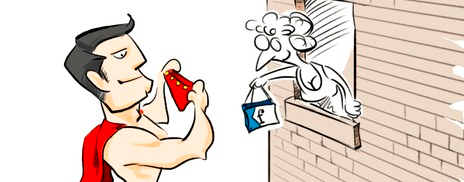
Every now and then I will stumble upon a cartoon I simply don’t get. At times I can stare at it for quite a long and still not get it. Some time ago I heard about Bill Bickel’s blog Comics I Don’t Understand. On CIDU he posts newspaper strips and webcomics that he, well, does not understand. Of course I had to ask for his expertise.
Since I didn’t bookmark the cryptic cartoons I had found in the past, I had to browse toonpool.com for some to illustrate this interview. Doing so I noticed two important differences I had to take in account: 1) We have a lot more illustrations and experimental cartoons, that aren’t meant to have a distinct meaning or gag in the first place 2) Several toonpool.com artists may post cartoons that are meant for an audience from their own culture. So.. the images I chose are cartoons I think I could be getting, i.e. cartoons that seem “international” and also look as if they have a simple meaning or punchline.
Bill, can you tell a bit about the history of the CIDU blog?
 I had — and still have — a friend named B. Joni who lives across the country. We wrote to one another frequently, and in years past we’d sometimes mail one another comic strips we didn’t understand. By 1994 we both had computers, and comics strips were starting to come online, so we were able to e-mail one another the comics. Brave New World!
I had — and still have — a friend named B. Joni who lives across the country. We wrote to one another frequently, and in years past we’d sometimes mail one another comic strips we didn’t understand. By 1994 we both had computers, and comics strips were starting to come online, so we were able to e-mail one another the comics. Brave New World!
But then she has to switch Internet Service Providers and could no longer receive e-mail attachments. I was already running a couple of web sites, and it occurred to me that if she couldn’t receive comics in the mail, I could start up an ad hoc web site just for the purpose of showing her the comics.
How did this become a public website?
Somewhere along the line, she passed along the address to some friends, who gave it to other friends, and at the same time I mentioned what I was doing to a kinsman and he passed along the address, and before long I was getting e-mail and comics from complete strangers.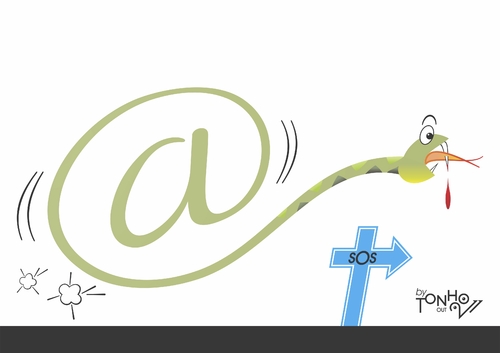
Then David Farley, whose “Doctor Fun” strip appeared frequently on CIDU, gave me a plug. Soon afterward the site was mentioned in the New York Times, and then in Entertainment Weekly’s “Must List” page – the same place my brother’s book Creepiosity got listed 14 years later, oddly enough.
Did you have any kind of cartoon/comic background before you started the page?
No background at all other than having read the comics since I was three or four. I can’t draw for shit. I did draw a comic once, though: to avoid failing a high school art class, I created a comic book – all of whose characters were constellations, so all I had to draw were combinations of white dots on black paper.
What, in your opinion, is the main cause for cryptic comics?
I’m not sure there’s a “main” cause, but here’s a partial list:
There are several instances of “This made sense to me when I thought of it at 3AM”. Then, there are gags based on regional knowledge the writer believes is universal. Or gags based on technical knowledge the writer believes is universal.
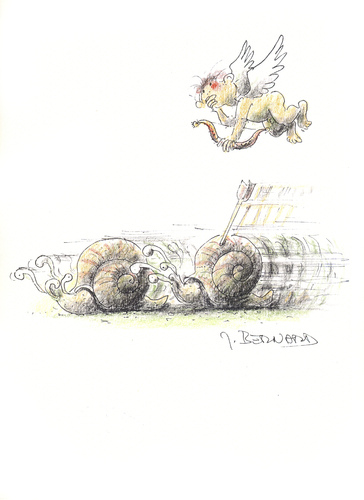 There are also those moments when a comic actually isn’t cryptic at all: it’s just plain not funny and I was looking for something that wasn’t there
There are also those moments when a comic actually isn’t cryptic at all: it’s just plain not funny and I was looking for something that wasn’t there
Sometimes the writer wanted to challenge his readers. Or he was being intentionally obscure to show off how clever he is. Then there are writers who are actually trying to get on CIDU.
And there are f***ing cats.
Wait.. how are cats a main cause of cryptic comics?
People have remarked – quite frequently and not without justification – that I simply don’t get any comics that involve cats.
In your FAQ you tell the original artists not to send in explanations. Is that something that actually does happen?
It did happen at first, before I added this to the FAQ. Still happens on occasion now, but invariably one of the regulars chastises the writer/artist before I ever see the comment. Self-policing communities; gotta love ‘em.
Dave Farley complains bitterly about this rule in his own FAQ, but it’s all in jest. The CIDU community misses Doctor Fun terribly.
 Have you ever had cartoons explained to you and then actually thought they were funny?
Have you ever had cartoons explained to you and then actually thought they were funny?
Of course.
You also post cartoons that are actually funny in addition to the ones you don’t understand. Why?
Out of respect for cartoonists. If I’m going to give them a hard time when they’re unclear, the least I can do is honor them when they really nail one. In the end, I’m a fan: I’d much rather appreciate a comic than be confused by one.
You have been collecting cartoons and reading other people’s attempts at explaining them for quite a while now. Has this changed your own perspective on cartoons in any way?
I don’t know, not really. I have gotten better at understanding how comics writers’ minds work. And I know a lot more than I used to about cats.
So, how DO comic writers’ minds work?
Like clockwork oranges.
Thanks for your time!
Title illustration: “Superman is Shopping” by Zenchip
]]>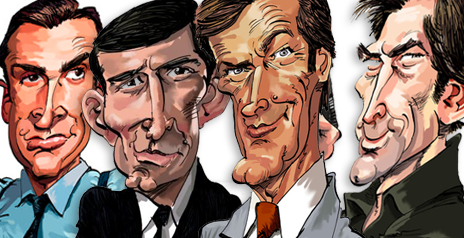 Sheffield-based artist Ian Baker has drawn gag cartoons for magazines like Reader’s Digest, Penthouse, or National Lampoon. He is also responsible for an amazing collection of caricatures based on characters from the twenty-two (or 23, 24, or maybe even 25) James Bond movies. If you are hoping for questions about the gag cartoons you will be disappointed.
Sheffield-based artist Ian Baker has drawn gag cartoons for magazines like Reader’s Digest, Penthouse, or National Lampoon. He is also responsible for an amazing collection of caricatures based on characters from the twenty-two (or 23, 24, or maybe even 25) James Bond movies. If you are hoping for questions about the gag cartoons you will be disappointed.Ian, I really like your Bond caricatures. What is it about James Bond that made you start this series?
I have alwa![]() ys been a fan of the James Bond films since I was a kid. In recent years I was involved in various Bond related projects, particularly in America, working with people who have had a long history working in the Bond universe on the film and literary side of things.
ys been a fan of the James Bond films since I was a kid. In recent years I was involved in various Bond related projects, particularly in America, working with people who have had a long history working in the Bond universe on the film and literary side of things.
I started working on a few caricatures for my own amusement really, but they soon started to get the attention of Bond fans around the world and before I knew it I was producing large numbers of these portraits.
I’ve been overwhelmed with the positive response I’ve had from Bond fans. The downside is that at one point MGM Studios in Hollywood threatened to sue me unless I stopped producing the artwork, but they backed down.
What kinds of Bond projects have you been working on?
 I was involved in a big project that unfortunately may not come to fruition now. I’m actually not allowed to talk about it, though. Seriously. Just like the real world of 007!
I was involved in a big project that unfortunately may not come to fruition now. I’m actually not allowed to talk about it, though. Seriously. Just like the real world of 007!
What’s your favorite Bond movie?
That’s a tricky one to answer; I love so many of them. I grew up in the Roger Moore era, and I loved all his films. Probably for his sense of humour and for the gadgets.
But I have to say that my favorite is probably Casino Royale. I thought the new Craig era brought with it a much grittier, down to earth feel that was right for modern times.
The new Casino Royale? Really?
Sure. The thing with Bond is that your favorite film can change depending on your age, or the way the world is at any particular time. When I was a kid I would say my favorite was probably The Spy Who Loved Me.
It’s still one of the very best, but back then, as a young kid, I was very impressed with gadgets, so that film fulfilled that. Right now I appreciate Bond being a much harder and more serious incarnation of the brand. I do think Daniel Craig is a very good actor, too. It’s funny but even though in real life I love technology and gadgets, what I want from Bond now is to not rely on them.
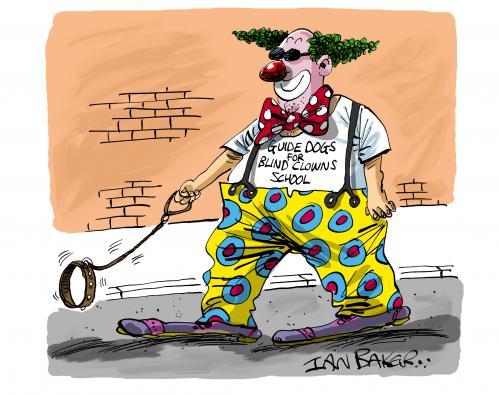 Is it getting harder to come up with Bond characters you haven’t done yet?
Is it getting harder to come up with Bond characters you haven’t done yet?
Not really, I’m not even half way through the collection. I actually get Bond fans emailing me requesting or suggesting particular characters to be added to the collection.
There have been a couple of Bond stars who, I’ve been told from my American sources, love the caricatures I’ve done of them – George Lazenby and Gloria Hendry. That’s so good to know.
There are still many characters that I need to do, some of them are major recurring characters too and it would be a huge oversight to not do them, so it will be a will be a while before I run out of steam with this project…Not forgetting of course that there is a new Bond film currently in production with all new characters to tackle.
How much time do your portraits usually take?
I work very quickly and seem to have a bit of a reputation for speed now. It varies. On average the black ink line work takes about five to ten minutes,and then I’ll add color
I might spend anything from 20 minutes to a few hours depending on its complexity.
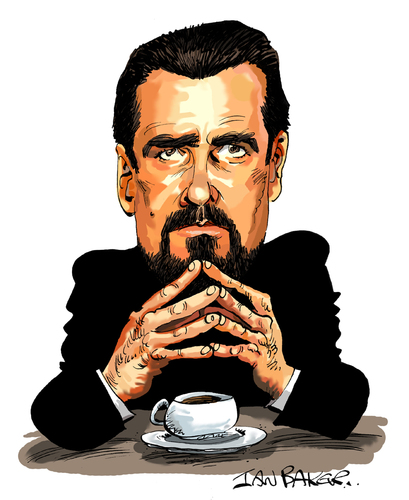 The fact that you are working so fast makes me wonder.. did you ever work as a street caricaturist?
The fact that you are working so fast makes me wonder.. did you ever work as a street caricaturist?
No, never. And I have never really seen myself as a caricaturist to be honest. I do caricatures when asked to, but it’s not my main area. I think nerves put me off doing live caricatures. Also, I prefer not to let the public see work that I’m not happy with… and doing that kind of work inevitable leads to work I am not proud of.
I greatly admire live caricaturists. Many of them seem to be able to hit a likeness straight away, every time, and that takes confidence. Unfortunately also, on a business level, I do feel that live street caricaturists are not paid what they deserve to be paid.
These days a new book of yours is coming out. Can you tell a bit about it?
It’s called “The Codgers’ Kama Sutra”. It’s in fact mainly a written book, which has a few cartoon illustrations scattered throughout it. I have worked a fair amount over the years as a comedy writer, and I wanted to do a book where I could showcase writing skills and let the cartoon side take a back seat.
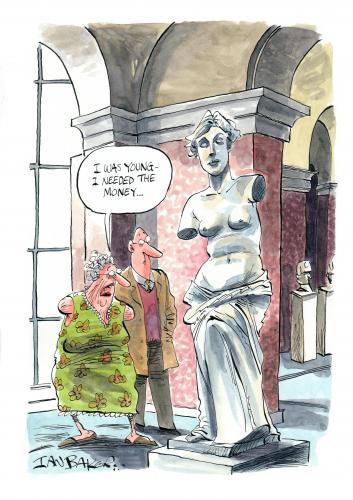 How did you end up with the idea for the book? You don’t seem that old..
How did you end up with the idea for the book? You don’t seem that old..
I’ve illustrated many books, written by other people, which are aimed at an older market – Mainly gift books that gently poke fun at people’s ages. I always wanted to write a similar book but with much more extreme, edgy humor.
I think a concept like the Kama Sutra is a gift for a satirist. Once I’d finished writing and illustrating it, it took a couple of years before I landed a publishing deal. Most publishers who saw the book found it to be a little bit too rude for their humor ranges.
Ultimately I submitted Codgers’ to Constable & Robinson in London, one of the oldest and most respected publishing houses in Europe, and I was delighted when they offered me a deal. A year on from signing the contract, I now have an advance copy of the book in my hands and look forward to the release of the book internationally on the 22nd of September.
If the book has been lying around for so long.. didn’t you feel tempted to change things.. redraw parts, add new cartoons, etc.?
This was one of the rare occasions where I felt the work I’d done had reached a satisfactory conclusion. I re-read it several times over the course of a year and it still made me chuckle every time.
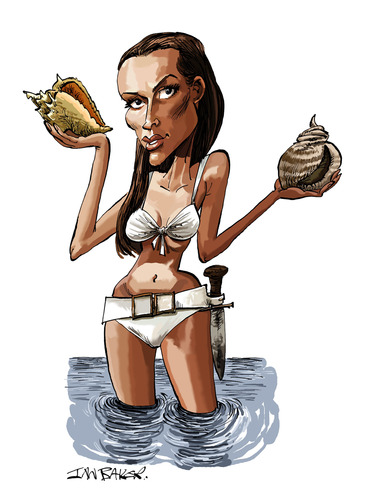 There was one thing I did go back and change though, and that was the cover artwork. The original cartoon, I felt, could be a lot better, so I did it again. However by this time the old cover was appearing all over the internet with the old cover cartoon
There was one thing I did go back and change though, and that was the cover artwork. The original cartoon, I felt, could be a lot better, so I did it again. However by this time the old cover was appearing all over the internet with the old cover cartoon
There is another book I am thinking of resurrecting at the moment – One I started working on about six years ago. That book will have to be totally started from scratch, as having recently seen the original work, I know the cartoons need to be drawn better. I think all of us, as cartoonists, never stop improving our skills and evolving.
I’m sure one day I will pick up the “Codgers’ Kama Sutra” and wish I could re-draw the illustrations or add a new chapter. But for now, I’m very happy with the finished book!
Thanks for your time!
]]>
Hayati Boyacıoğlu is a Turkish-German cartoonist. His cartoons frequently deal with issues of integration and cultural relations.
Hayati, in the past weeks you posted several cartoons showing couples – most of them very unlikely ones. Where did that come from?
![]() You will see couples anywhere you go – on the subway, at a doctor’s office.. That’s when I start wondering what they do, what they tell each other, how they found each other, why him, why her… There’s hardly any subject more rewarding for a cartoonist than relationships.
You will see couples anywhere you go – on the subway, at a doctor’s office.. That’s when I start wondering what they do, what they tell each other, how they found each other, why him, why her… There’s hardly any subject more rewarding for a cartoonist than relationships.
Was there any particular couple that started the whole thing?
Yes. Back in 1995 I published a book that had a couple on the cover page – a punk and a Turkish woman with a headscarf. I saw those two sitting on a bench at Moritzplatz. In a city like Berlin these kinds of things are actually quite frequent.
You make up names for all of your couples…
Yes, but I only started doing this recently. It adds a certain warmth to a cartoon. I also want to add a common element to my couple drawings: it’s meant to show that we are all human beings, even though some people have a hard time accepting that.
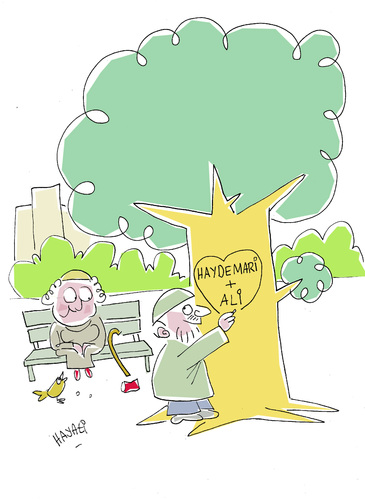 For example, I did this cartoon about “Heidemarie and Ali”. In that one Ali cuts both their names into a tree. These kinds of things just have to happen if you take into account that the first Turkish migrants came to Germany in 1960. It’s well possible that a Turkish man who arrived back then fell in love with a German. But in everyday life you see these things way too rarely.
For example, I did this cartoon about “Heidemarie and Ali”. In that one Ali cuts both their names into a tree. These kinds of things just have to happen if you take into account that the first Turkish migrants came to Germany in 1960. It’s well possible that a Turkish man who arrived back then fell in love with a German. But in everyday life you see these things way too rarely.
You were born in Istanbul and your wife is from Bremerhaven. Does you own experience influence your couple cartoons in any way?
Sure. We have known each other since 1978, when she was 14 and I was 17. I asked her to teach me German… She still does.
You also do political cartoons, say, about famine in Somalia..
There is a kind of scheme behind that. I will draw a number of “bourgeois feelgood cartoons” and then I will do one about starving Somalian children.
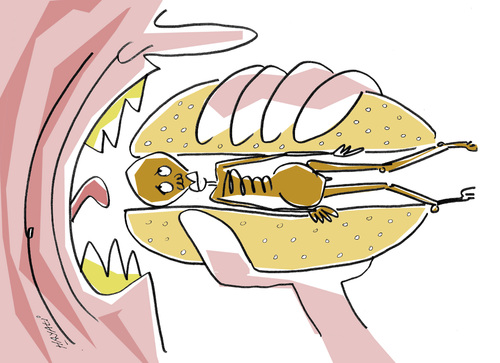 Do you draw it in that order or do you keep back the grisly ones to use them in the proper moment?
Do you draw it in that order or do you keep back the grisly ones to use them in the proper moment?
Sometimes I think about trying to control this.. but there’s no real need to. Life does that by itself. I will draw something about couples switching clothes and all of a sudden my routine is interrupted by a sinking ship with 20 refugees aboard and other people doing nothing. You just have to draw something about that.
Is there any agenda behind your cartoons?
Dario Fo once said that if you want to make people understand something you have to make them laugh. Because that’s when their brains will open up and you can add knowledge.
The problem with toonpool.com is that the audience is composed of artists, of satirists. There’s no need to teach each other. On Facebook, for example, I will get very different reactions to my cartoons.
Several of your political cartoons deal with Turkish issues, for example with the recent elections. Can you tell a bit about Turkish cartoons in general?
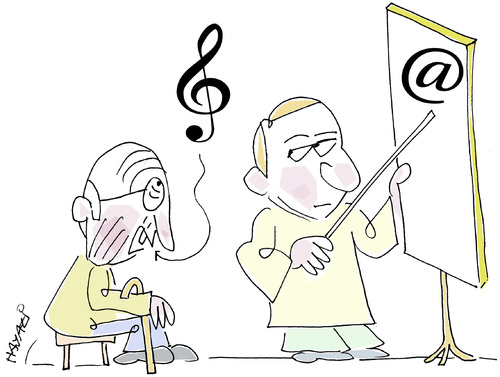 In Turkey, the newspapers’ headquarters are mostly based in Istanbul. Except for about four pages of the international issues, everything’s produced there.
In Turkey, the newspapers’ headquarters are mostly based in Istanbul. Except for about four pages of the international issues, everything’s produced there.
So, those international issues will hardly produce their own editorial cartoons. Perhaps because it’s hard to control editorial cartoons. In effect, most editorial cartoons deal with Istanbul issues and hardly ever with things happening anywhere else.
Are there any differences to German cartoons when it comes to humor?
Yes. There are basically two types. The first one does not really exist in Germany. It’s satirical magazines that are very cheap. Examples would be Leman or the now-defunct Gırgır.
German Titanic or Eulenspiegel cost 4 Euros each and, if you want to understand them you have to be well-read, know a thing or two about satire, etc. It’s not for everyone.
The Turkish magazines cost something like 25 cents and they are not too “high-brow”. Satire should be folksy and accessible for everyone – populist in a good way. I am trying to keep things simple, even though it doesn’t always work. Maybe that’s a point where I’m influenced by Germany.
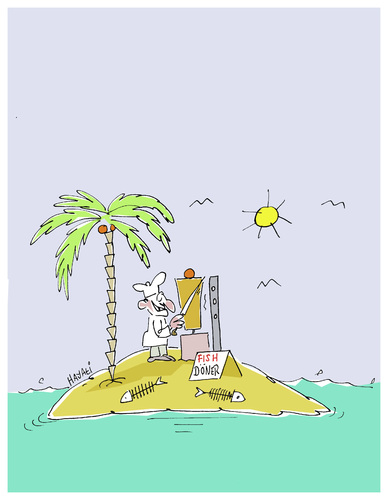 Isn’t there a danger that populist cartoons can very quickly turn to propaganda?
Isn’t there a danger that populist cartoons can very quickly turn to propaganda?
I don’t think so. Readers would notice this very quickly. And they will punish magazines by simply not buying them the following week.
How about the second type of cartoons?
Those are more artistic and don’t use captions. That’s one thing that sometimes poses problems for cartoonists from Yugoslavia, Romania, Bulgaria, and the like. Germans always use captions. Even on toonpool.com you need to fill in a title but, you know, the drawings are supposed to speak for themselves.
Where is this type usually published?
Artists will publish books or display them at exhibitions. There were a couple of more sophisticated satire magazines, but those never really worked.
Are you still in contact with cartoonists from Turkey?
Yes, I am. Thanks to toonpool.com, among others. I started drawing back in school, when Gırgır was still around [editor's note: Gırgır was originally published between 1972 and 1989].
I met a lot of like-minded people then. Some of them – like Erdogan Karayel - I met again in Germany. Others I found online. And, of course, I met a lot of new people.
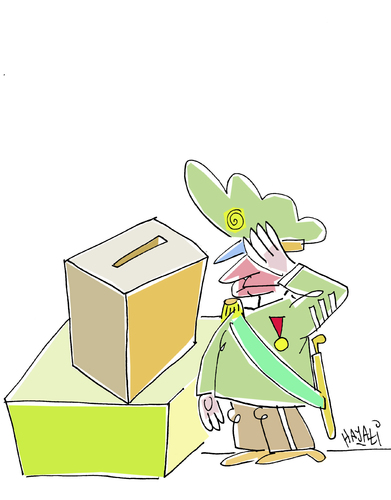 What are the main differences in opinion between “exiles” and artists back in Turkey?
What are the main differences in opinion between “exiles” and artists back in Turkey?
It always depends on how long you have been abroad. If you left only two or three years ago you can live here as you would have back in Turkey. You don’t really speak the language and you can stay at home and watch Turkish television. If you have been here for 20 or 30 years, though, if you keep your eyes open, you will change.
Which of your own attitudes, would you say, have changed?
I see some things differently. Some things that would be taboo over there, I don’t really mind anymore. When the Turkish military’s chiefs of staff resigned, mine was one of very few cartoons on this topic.. and it applauded the fact that they gave in to the power of the people. I hardly got any reactions on that one from Turkey.
Thanks for your time!
]]>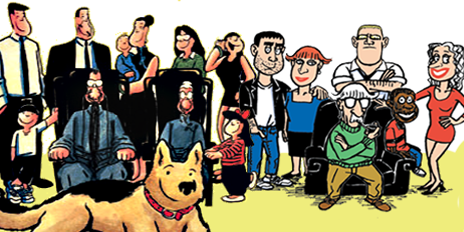
Cheah Sin Ann – also known as both “Cheah” and “Sinann” – was born in Malaysia and currently lives in Singapore. In 1986 he started drawing a strip called “The House of Lim” for the Straits Times, Singapore’s largest English language newspaper.
 Sin Ann, you write that you created the first “Singapore-made English language daily cartoon strip”…
Sin Ann, you write that you created the first “Singapore-made English language daily cartoon strip”…
Yes, when I first joined the Straits Times, there weren’t any locally-made strips. Perhaps because those were still the early days. I pitched the idea of a series on a Chinese family and the editors bought it. There have been a number of works created in Singapore since.
If there were no local cartoons, what others were there?
If I’m not mistaken, most of the cartoon strips were from the American syndicates – stuff like Garfield, and the Peanuts.
How many different strips do you draw at the moment?
Currently, I maintain two working cartoon strips. The daily Billy & Saltie and the weekly Event Horizon. I also post that one on toonpool.com, well, weekly.
I have a third which I’m keeping under wrap for the most part for now. It’s called Beijing Life and about a modern ‘Mad About You’ type couple in the Chinese capital.
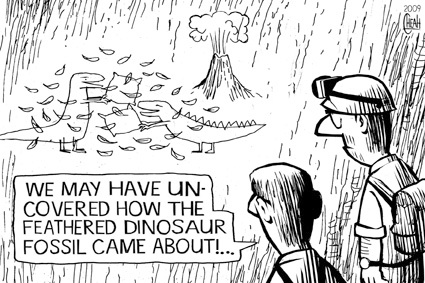 Singapore sounds like a melting-pot of different cultures. Does this figure into your cartoons in any way?
Singapore sounds like a melting-pot of different cultures. Does this figure into your cartoons in any way?
Yes, Singapore has many cultures I think mainly because it was a major port for the trading routes in the old days and the various immigrants settled here.
I don’t know if they figure in my cartoons but I think humor is universal and culture only provides the platform. Case in point, my strip, Murphy’s In-Law dealt with Irish culture but the jokes were essentially still jokes you and I can identify with. [characters from this strip are on the right side of the title image]
How did you decide to do strips about Irish and Chinese families? Is there any personal connection? Your own name sounds Malay to me… I mighty be totally off on that last one, though.
My name’s actually Chinese – Cheah Sin Ann – but my last company contracted it to Sinann Cheah for their computer system. This would explain the Chinese family strip. [characters from "The House of Lim" are on the left side of the title image]
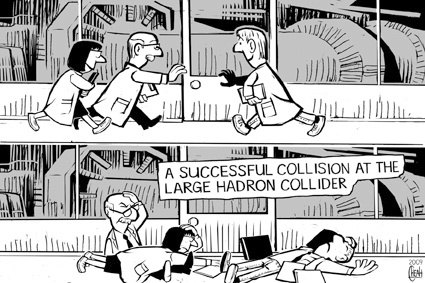 As for Murphy’s In-Law, my wife is from County Kerry, Ireland. So I had plenty of info about Irish culture. And Guinness.
As for Murphy’s In-Law, my wife is from County Kerry, Ireland. So I had plenty of info about Irish culture. And Guinness.
There are are four official languages in Singapore how does that affect your everyday life? Do you switch between languages?
Effectively, I speak English, Malay and a dialect of Chinese and yes, I use those languages in the restaurants at the markets, etc..
Have you ever drawn comics in another language?
No, although I would very much like to. And that’s an interesting point you’ve raised: Would humor in English work just as well in German, French or Spanish? Would the irony or sarcasm be lost in translation? Even American humor isn’t the same as British humor.
How does this work in a multicultural situation? Do you see any differences in humor between the ethnic groups of Singapore?
All the races speak Singlish besides their mother tongue and we have our own brand of humour that takes an outsider a while to get. It’s full of local slang and innuendos. The same as in other countries, I guess.
The universal point i was trying to make is that all cultures have their hangups with mother-in-laws, shopping, people who talk too much, bad drivers, etc. I like to show how a particular group deals with them, preferably with a nice twist.
You mentioned a new strip about life in Beijing. What kind of market are you aiming at with that?
I’m really not sure about Beijing Life, to be honest. Unless I get some help from the inside and the outside. It won’t be easy to introduce the cartoon and, more importantly, the humor, to China. From what I know, there’s no such thing as irony there.
Thanks for your time!
PS: Samples from “House of Lim” and Sinann’s other strips can be found on his website.
1. Which movie/TV character you see yourself as and why?
The movie character I see myself as would probably be the lead part in the film ‘Chocolate ‘ for so many reasons!!!
2. What are your New Year’s resolutions?
My new year’s resolution was to eat more chocolate and exercise less, or was it the other way round? I choose not to remember.a
3. What bores you the most?
My day job bores me most at the moment.
4. Do you like your place or would you like to live somewhere else?
I love living in East Anglia and probably won’t ever go too far from it if I can avoid it. I have tried but always seem to end up returning here.
5. What are you able to do that Superman can’t do?
Things I can do that Superman can’t, have a baby, go into the Ladies toilets, walk into a phone box without changing costume.
6. If you were sleep walking one night, where would you probably wake up the next day?
If I were sleep walking I would probably wake up in the nearest chocolate factory/ sweet shop/ ice cream parlour.
7. What would you wear to be kicked out from a black tie cocktail party
I could wear a cocktail dress and still get thrown out of a cocktail party.
8. Tell me the biggest prank you did on a friend.
The biggest joke I ever played on anyone was one of my ex managers. We had no staff and it was very difficult, but me and two of my collegues wrote out really ridiculous letters of resignation and handed them to him altogether. He went white. Five minutes later we watched his face change as he opened the first letter, then he realised it was April Fool’s Day. The letters went right round all the managers at our supermarket, we’d written we were leaving to become strippers or prostitutes or something!!!! All very ridiculous stuff.
9. How to ruin your vacation?
I’d have to get food poisoning or a tooth ache to ruin any holiday.
10. If I gave you a giraffe, where would you hide it?
I would hide a giraffe in the middle of an English supermarket with a sign round it’s neck saying ‘I’m a giraffe’. English people don’t see anything in front of them and certainly don’t read signs. They just complain if there’s not a sign. We’re a strange breed.
11. What do you do when you see the glass half empty!
What do I do with a glass half empty? Depends what’s been in it.
Click on image to enlarge










Credits to Nicoleta Ionescu for talking with Kerina Strevens
]]>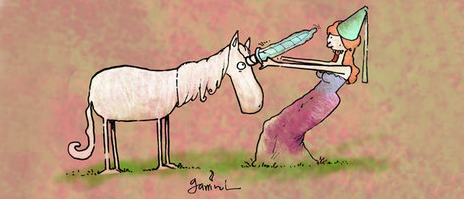
“Adult cartoons” is a topic that I have tried to avoid so far. There are mainly two things that I find problematic about the majority of sex-themed cartoons. The first one is that they are often more annoying than anything else. Basically they are the graphic equivalent of someone yelling “PENIS! See, I said PENIS!!!! And there is nothing you can do about it because this is the INTERNET!!! P-E-N-I-S!!!. The second problem is that so many of them perpetuate a sexist ideology that hasn’t changed much since the early days of Playboy.
Still, I thought it would be interesting to learn more about the motivation and thoughts of “adult” cartoonists. Gustavo “Garrincha” Rodriguez is a Cuban cartoonist and illustrator who moved to North Miami Beach, Florida in 2005. I admire many of Garrincha’s works: his vectorized caricatures are inventive and immediately recognizable and his line drawings have have an almost Sempé-ish lightness to them. On the other hand he also does a series of cartoons aptly titled “Dickies”. Hence this interview:
![]() Gustavo, what’s the story behind your series of sex-themed cartoons?
Gustavo, what’s the story behind your series of sex-themed cartoons?
Sex is still taboo to many people. Well, not sex, but talking or joking about it. Which is, as we all know, stupid. And hypocrite. And wonderful to depict.
So yeah, I’m a bit provocative there. I didn’t have a space to publish any of that material back in Cuba. Coming to the States and starting a blog where I can publish whatever the hell I wanted was therapy, catharsis, a test and healthy creative exercise all in one.
Why couldn’t you have done the sex cartoons from Cuba?
I wouldn’t have been able to set up a blog in Cuba mainly because Internet connection is scarce and state-controlled. Even having a computer is a big deal there.
Most artists use computers as an extension of their work in government propaganda, or to talk about politically correct subjects in sports, culture, or technology. Because they want to or because they know they are being watched.
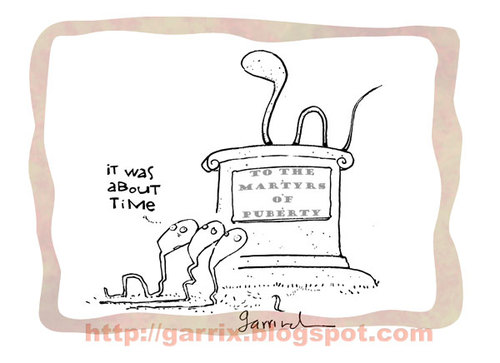 There is that thing with the control and censorship government bureaucrats take so seriously. They keep reminding everybody in earshot that the Cuban Revolution is a superior project. So revolutionary morality – whatever that means – is something they try to keep an eye on.. Soft erotic content is OK sometimes in one of the two humor publications nationally distributed, but drawing penises is a no no, to put it grossly.
There is that thing with the control and censorship government bureaucrats take so seriously. They keep reminding everybody in earshot that the Cuban Revolution is a superior project. So revolutionary morality – whatever that means – is something they try to keep an eye on.. Soft erotic content is OK sometimes in one of the two humor publications nationally distributed, but drawing penises is a no no, to put it grossly.
I would have thought that Americans would be more touchy about all things sex-related..
Mainstream America is conservative and sometimes prude. But there are pockets or niches. The Internet definitely opens extra doors.
Having a personal blog and a website where I can publish everything is something I could have never dreamed of in Cuba. And so far I haven’t had anybody in the States telling me to shut it down because the content is indecent or politically incorrect.
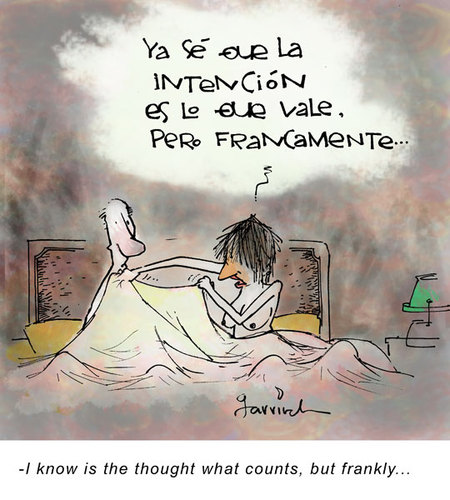 How is the ratio of sex cartoons to family-friendly ones in your current work?
How is the ratio of sex cartoons to family-friendly ones in your current work?
I would say is a quarter of what I draw, counting comic strips, illustrations, caricatures, editorial cartoons and gag cartoons. Maybe less.
It’s just that I find it relaxing being provocative and finding accomplices in the more familiar or intimate circuit of my reduced number of blog readers, Facebook friends or toonpool.com users. Although the latter two imply a number of readers not as small as I have imagined.
The majority of your sex-themed cartoons takes a males perspective with women and their genitals being demoted to objects of desire for the penile protagonists. Why such limitation?
Because that’s how pathetic we are.
Who is “we”?
Uh… Men as a group? Mankind in general?
I am pretty sure that – at least – one half of mankind would disagree. So, let’s stick with “men as a group”. Do you think that in the end, looking at yourself and other men, it all comes down to that?
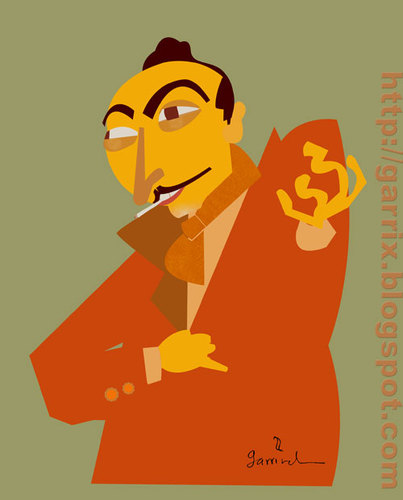 Oh, sure! I know for a fact that very few people would admit that they have something pathetic in their lives. Me, I try to stay honest. And self-deprecating helps, no doubt.
Oh, sure! I know for a fact that very few people would admit that they have something pathetic in their lives. Me, I try to stay honest. And self-deprecating helps, no doubt.
I don’t really believe my approach to sex in cartoons should be taken as an “in the end” judgment of any kind. That’s too serious of a stance. It’s like making Bob Dylan’s poetry a philosophy of life, a doctrine. I mean, come on! If my male readers laugh at themselves with my toons, fine! If they don’t, too bad for them.
Some of my cartoons focus on sex sometimes to remind people that indeed they are focused on sex but lots of them won’t admit it. I make that matter public, and I try to do it in a funny way.
Is there something inherently funny about sex and male genitals in particular?
It all depends on whose genitals are we talking about.
So, whose genitals are funny?
“Ha-ha-ha”-funny or “That’s weird!”-funny? Well, I guess Khadafi and Hugo Chavez think theirs are cute. Even each other’s.
Look, penises are cucumbers with an attitude. Women genitalia on the other hand, are very… How to put it? Have you seen Gerald Scarfe’s flowers in Pink Floyd’s The Wall? Scary, huh?
Women are too gorgeous to reduce them to a walking vagina or a dancing pair of boobs. I’m not satisfied at all with the vaginas I draw, I have to say. To sum up, penises are excellent characters to draw about the male brain.
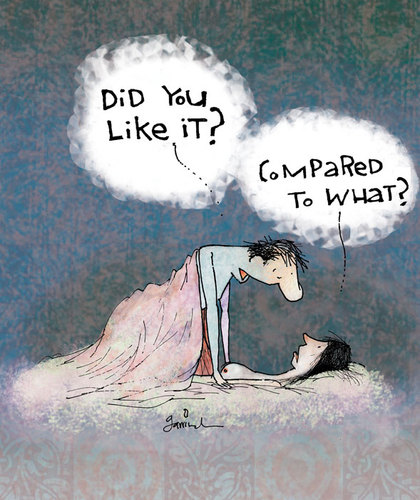 How do people react to your explicit cartoons? Is my question about limitation one that often comes up?
How do people react to your explicit cartoons? Is my question about limitation one that often comes up?
I can only tell from comments and emails, but it has been mostly a popular reception. Men and women alike seem to like ‘em.
How about other people’s adult cartoons? Do you enjoy those?
If you have sense of humor in treating sex as a theme, and if you have good drawing and conceptualizing skills, it means to me that you are a special person who chose to enjoy life.
The wit, the high quality of the drawings and the liberating feeling of mocking our sorry human nature are things not to be taken lightly. So yes, I do enjoy other artists’ cartoons about sex if their work is funny, well-drawn and communicates effectively. I think I should start a club.
Thanks for your time!
]]>
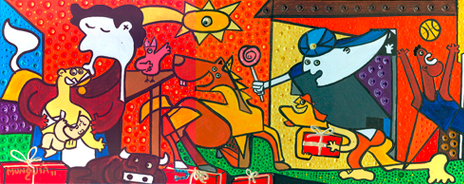
Francisco Munguía is based in San José, the capital of Costa Rica. He is a full-time cartoon artist doing newspaper cartoons, paintings, ceramics murals and even computer games. Francisco and his wife Debora live together with their two sons and 25 dogs.
My first interaction with Munguía took place about a year ago when I messed up his first name in an article about cartoon parodies of famous works of art. I have to admit that this still bugs me. Here is a proper interview:
![]() Francisco, you often quote well-known paintings in your cartoons. Can you tell a little bit about that?
Francisco, you often quote well-known paintings in your cartoons. Can you tell a little bit about that?
You’re right. Parodies of famous paintings make up for the greatest part of my “Calcamunguías” series. By now I must have done more than 200 of these reinterpretations. I prefer to caricature a work of art rather than politicians.
People from Guatemala, Holland, Korea, Ghana, or Spain easily recognize the Mona Lisa, or Munch’s Scream, but I think they hardly know the name of the president of my country. Chances that it will still be like this in 100 years are very high.
So, people like the parodies?
Yes, I started this series in 2008 and it became very popular. I even managed to organize a traveling exhibition of several rooms. Humor and parody are a great way to bring universal art to young audiences. In each exhibit my paintings are accompanied by a photo of the original painting, and the names of the piece and the artist. I also use the paintings to carry forward messages of animal welfare, ecology, and social interest…
While I love art, lots of paintings often seem boring to me – without humor and color. I’ll arrange that. My works are an upgrade, so to say.
What exactly do you mean by “boring”?
Over time, art has become more colorful and humorous, less realistic in form and more realistic in content, Michelangelo was gifted but his themes are limited by religious mythology. Rembrandt is a great artist but I do not like the many shadows in his paintings. Goya is extraordinary and very critical, but his works are void of color and the humor is very black.
I prefer the toonpool cartoons to Mona Lisa, but I enjoy Mona Lisa much more than CNN news. The best example I have is Guernica, one of my favorite paintings – a large painting, very critical, but all the characters suffer. It’s gray, it’s sad, and it is a cruel reflection of war. My version is happy and optimistic. The family is celebrating the birth of the child, they live in peace surrounded by animals. It is full of color, like an exorcism of the original.
Still, there must be something you like about the original paintings.. right?
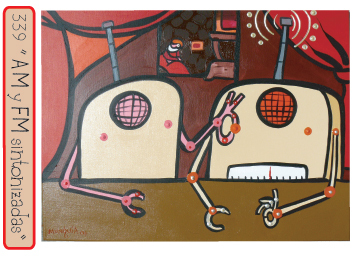 You can learn many things from works of art from the past – composition, color, history, allegory, symbolism. But I prefer the more recent artists: Van Gogh, Picasso, Duchamp, Magritte. The latter being very colorful, very symbolic, and very close to cartoons.
You can learn many things from works of art from the past – composition, color, history, allegory, symbolism. But I prefer the more recent artists: Van Gogh, Picasso, Duchamp, Magritte. The latter being very colorful, very symbolic, and very close to cartoons.
How did you decide on the color scheme you are using?
Costa Rica is a very colorful place. This has definitely influenced my art. I use a preset color palette when working on the computer. In my paintings I am more free. I use intense and plain colors, I will create texture by overlapping spots, dots and drops of pigment. I hardly ever use shadows – I am all for day-life, I love the light. Coloring is the most spontaneous part of my work, it is like a game.
Your cartoons look as if they are done very quickly. Is that true?
I am a fast artist. Coming up with ideas may take some time but I have so many in line that I have more ideas than time to realize them.
Some of my drawings take 20 minutes from the white sheet to adding color on the computer. I am even faster when I do several pieces at once. I can paint up to three pictures at once and finish them in one day.
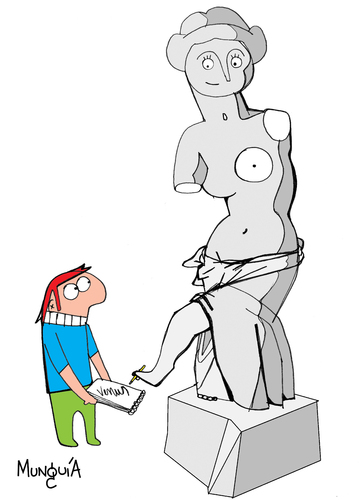 I paint murals of 30 square meters in four hours, but my ceramic pieces, for example, take me a couple of weeks. My largest mural took me two weeks with the help of one assistant. But there was also one that lasted two months. It was a pedestrian bridge that was painted underneath, inside, outside and everywhere. I needed cranes, extensions and several assistants for that one.
I paint murals of 30 square meters in four hours, but my ceramic pieces, for example, take me a couple of weeks. My largest mural took me two weeks with the help of one assistant. But there was also one that lasted two months. It was a pedestrian bridge that was painted underneath, inside, outside and everywhere. I needed cranes, extensions and several assistants for that one.
What, exactly, is the jobs of the assistants?
For my murals I cooperate with the community where I paint. Neighbors join the production as volunteers. Often they will ad the colors to the drawings – sometimes even little kids will paint a small piece. This way they become part of the art and the neighborhood improvement.
Other things assistants will do is to clean my brushes, put the paint into little containers for the use of volunteers. I am responsible for all drawings, for the coordination, I will fix errors made by volunteers and will finally add all the lines that define the painting.
Which do you like better – the murals or the small formats?
It’s hard to choose. The mural brings me closer to communities, but in the smaller formats I can do at home even if it is raining. The decision for “micro” or “macro” depends on the needs of the moment, and my time. Also the murals need sponsors, the small formats don´t.
Thanks for your time!
]]>


